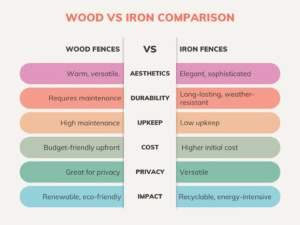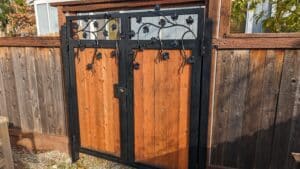In the diverse landscapes of California, from the bustling streets of Los Angeles to the serene vistas of the Napa Valley, fences do more than mark boundaries; they reflect the character and style of a home. Wrought iron fences, with their elegant designs and enduring strength, have long been a favored choice among Californian homeowners, celebrated for their durability and security. Yet, as we navigate through the myriad of home design and landscaping options, it becomes apparent that there’s a broader palette to consider. This brings us to the charming alternative of wooden fences. Our aim in this post is not to detract from the time-honored choice of wrought iron but to illuminate the instances where wooden fences might be a more apt choice for California homes. Through an unbiased comparison, we hope to equip homeowners with the knowledge to make informed decisions that best suit their property’s aesthetic, functional needs, and environmental considerations.
| Feature | Wooden Fences | Wrought Iron Fences |
|---|---|---|
| Aesthetics |
|
|
| Cost |
|
|
| Maintenance |
|
|
| Durability |
|
|
The Appeal of Wooden Fences
Aesthetic Versatility
Wooden fences bring a versatility unmatched by any other fencing material, capable of morphing from the quintessential white picket dreamscape to the sleek, contemporary lines of a modern design with ease. This chameleon-like quality allows wooden fences to harmonize with California’s wide array of architectural styles—be it the Spanish Revival villas, the quaint Craftsman bungalows, or the cutting-edge modernist homes dotting the coastline. The natural texture and warmth of wood can enhance a home’s curb appeal, adding a touch of rustic charm or refined elegance, depending on the chosen style and finish.
Natural Insulation
Beyond their visual appeal, wooden fences serve a practical purpose in creating private, serene outdoor spaces. Wood acts as a natural insulator, absorbing sounds and creating a quieter, more peaceful environment. This quality is particularly beneficial in densely populated urban areas or neighborhoods close to busy streets, where noise pollution can detract from the tranquility of home life. By choosing a wooden fence, homeowners can carve out a secluded oasis amidst the hustle and bustle, making their backyard a haven for relaxation and family gatherings.
Environmental Considerations
In today’s eco-conscious world, the sustainability of building materials is more important than ever. Wood, as a fencing material, boasts environmental benefits that resonate with the values of environmentally conscious homeowners. Being a renewable resource, wood has a lower carbon footprint compared to metals or plastics. When sourced from responsibly managed forests, wooden fences can be an eco-friendly choice that supports the health of the planet. Additionally, wood’s natural biodegradability means that, at the end of its life, it won’t linger in landfills for centuries like some synthetic materials. This aligns with a sustainable lifestyle, offering a fence option that’s as kind to the earth as it is aesthetically pleasing.
These aspects of wooden fences—ranging from their aesthetic versatility and natural insulation properties to their environmental benefits—present a compelling case for considering wood as a viable, even preferable, choice for fencing in California homes.
Maintenance and Longevity of Wooden Fences
Durability Concerns
One of the most common hesitations about choosing wood for fencing materials relates to its durability. In California’s varied climates, from the moist, foggy conditions of the coast to the dry, intense heat of the desert regions, wood is undoubtedly challenged by the elements. Additionally, concerns about pests such as termites, and the potential for rot, further contribute to reservations. However, with advancements in wood treatment and protective finishes, these concerns can be significantly mitigated. Choosing the right type of wood is crucial; cedar and redwood, for example, are naturally resistant to decay, pests, and moisture, making them excellent choices for the California climate.
Maintenance Requirements
To ensure the longevity of a wooden fence, regular maintenance is key. This includes periodic staining or painting to protect against UV damage and weathering. Sealing the wood helps to repel moisture and prevent rot, while also preserving its appearance. Inspecting the fence annually for signs of damage, such as loose boards or posts, and making prompt repairs, is also critical to prevent minor issues from becoming major problems. Though this maintenance requires effort and expense, it’s essential for extending the life of a wooden fence.
Longevity Comparison
When properly maintained, a wooden fence can last anywhere from 15 to 20 years, depending on the wood type and environmental conditions. In contrast, wrought iron fences, with their superior durability and resistance to weather and pests, can last decades longer. However, iron fences are not without their maintenance needs; they require regular inspections for rust and may need repainting or rust removal treatments. Ultimately, the choice between wood and wrought iron may come down to a balance between aesthetic preferences, maintenance commitment, and budget considerations.

Legal and Environmental Considerations
Local Regulations
Before embarking on a fence installation project, it’s imperative to familiarize oneself with local building codes and regulations. California’s diverse municipalities may have specific restrictions regarding the materials used, the height of the fence, and how close it can be built to property lines. In some historic districts or homeowners association (HOA) controlled areas, the choice of fencing material and design may be subject to additional approvals. Ensuring compliance with these regulations not only avoids legal headaches but also respects community standards and preserves neighborhood harmony.
Sustainability Practices
The environmental impact of building materials is a growing concern for many Californians. Opting for sustainably sourced wood or certified lumber is a step towards reducing the ecological footprint of a fencing project. Look for wood certified by organizations such as the Forest Stewardship Council (FSC), which ensures that the timber has been harvested in an environmentally responsible, socially beneficial, and economically viable manner. Choosing sustainable materials supports forest conservation efforts and promotes a healthier planet. Additionally, considering the full lifecycle of the fencing material, from production to disposal, can guide more environmentally responsible choices, aligning home improvement projects with broader sustainability goals.
Making the Right Choice for Your Home
Assessing Your Needs
Choosing the right fence for your California home involves a careful consideration of your priorities and needs. Aesthetics play a crucial role; the material and style of your fence should complement your home’s architectural design and landscape. Privacy is another significant factor, with wooden fences often providing a more solid barrier compared to the open designs of wrought iron. However, maintenance and budget considerations cannot be overlooked. Wooden fences require more upkeep to maintain their appearance and durability, while wrought iron fences, though initially more costly, offer longevity with less frequent maintenance. Balancing these factors—alongside considerations for durability and environmental impact—will guide you toward the fencing option that best aligns with your lifestyle and values.
Consultation with Professionals
Every property is unique, and consulting with fence installation professionals can provide insights tailored to your specific situation. Experts can offer advice on the best materials and designs for your home’s climate, soil type, and aesthetic, as well as navigate local regulations and sustainability concerns. A professional consultation ensures that your fencing choice not only meets your functional needs and preferences but also adds value and beauty to your property.
Final Thoughts
The decision between wooden and wrought iron fences is not a matter of right or wrong but of what is best suited to the individual circumstances of your home and personal preferences. Both materials offer distinct advantages, from the warm, natural appeal of wood to the enduring elegance and security of wrought iron. By weighing the benefits and considerations of each, homeowners can make a choice that enhances their home’s curb appeal, privacy, and value.
Conclusion
Throughout this discussion, we’ve explored the distinctive qualities of wooden and wrought iron fences, from the versatility and natural beauty of wood to the durability and classic elegance of iron. We’ve delved into maintenance requirements, legal and environmental considerations, and the importance of aligning your choice with your home’s specific needs and your personal priorities.
At Irish Iron, our commitment is to guide California homeowners through the process of selecting the perfect fencing solution. We understand that each home is a reflection of its owner’s tastes and values, and we’re here to offer our expertise in making your vision a reality. Whether you’re drawn to the charm of wooden fences or the resilience of wrought iron, we’re equipped to provide you with high-quality options that cater to diverse preferences and needs.
We invite you to contact us for more information or to schedule a consultation. Let us help you make an informed decision that will beautify and secure your home for years to come.


